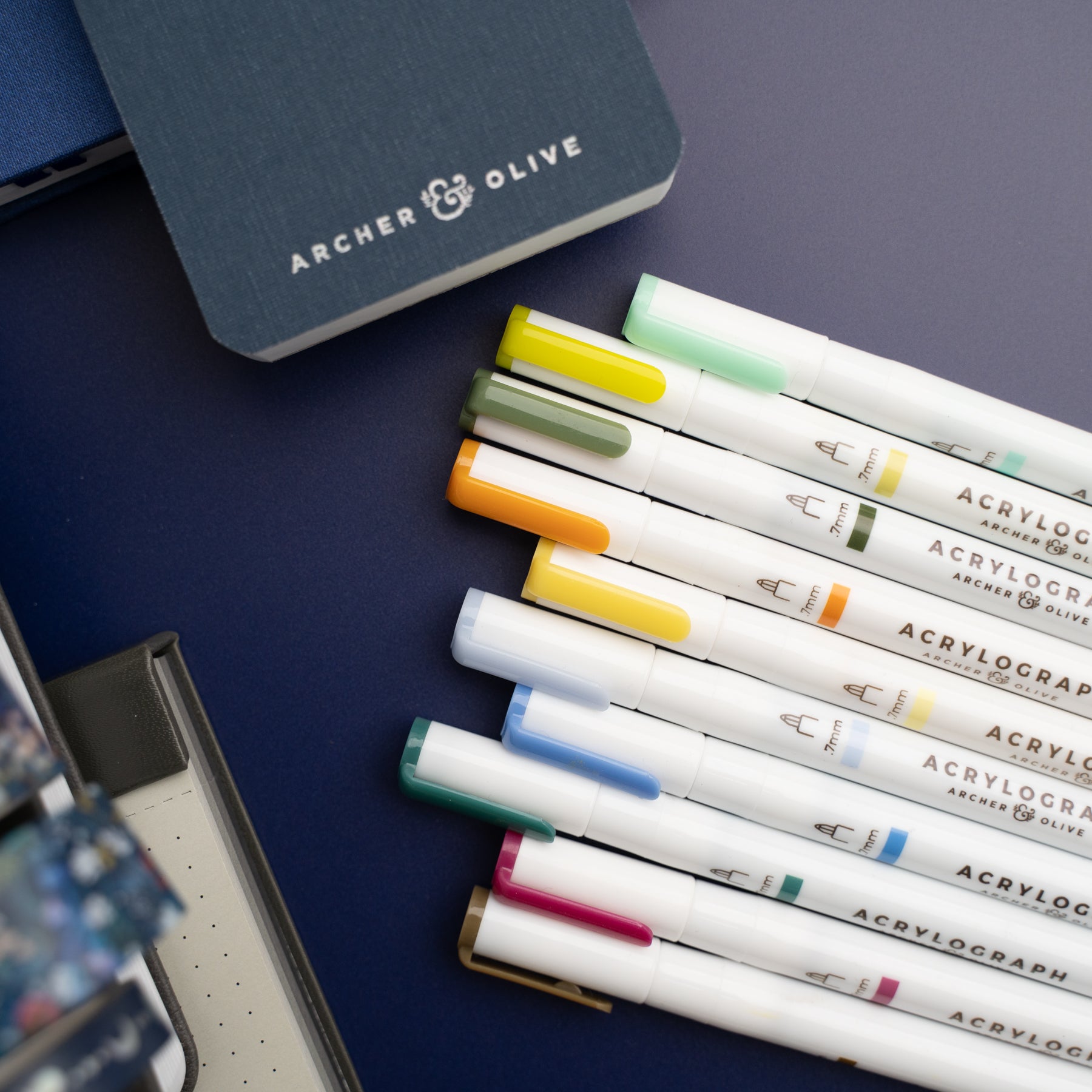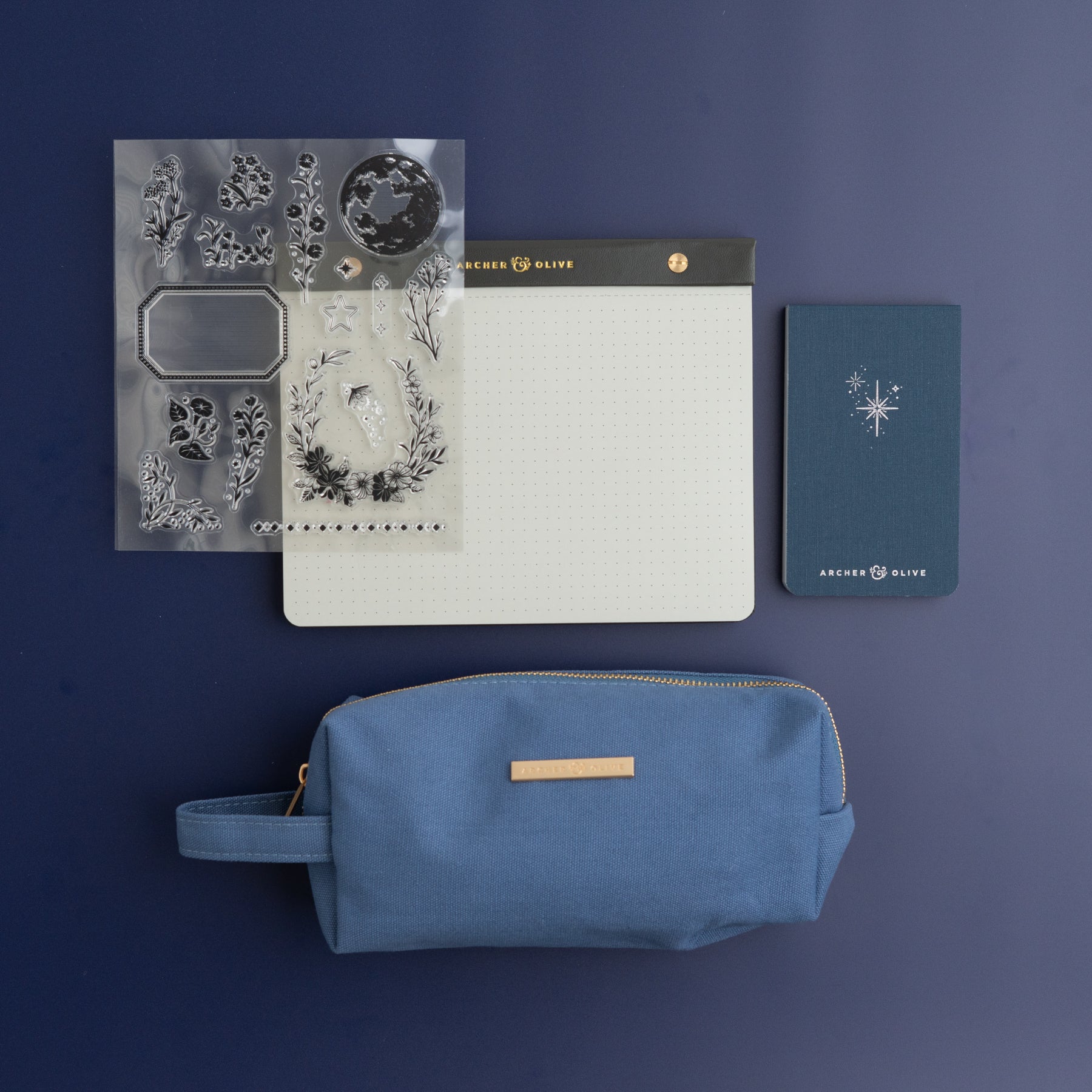Whether you enjoy it or not, tracking your finances and being mindful of your ingoings and outgoings are crucial to adult life. It seems like I’m in the minority, but I actually really enjoy keeping on top of my finances. Do you like to? Or do you bury your head in the sand, avoid looking at your statements and hope you’re ok? Well I’m here to tell you that you need to STOP burying your head in the sand. With just two bullet journal spreads you can be much more aware of your finances, and ultimately less stressed about them. You can also start to see areas you can save money and put it towards something you’ve been wanting such as a new journal, a holiday or even a house deposit.
In this blog I’m going to go over the two main spreads I use, show you a way to track your wage if you don’t have a regular monthly income, and a few saving tips that have really helped me!
Recommended Supplies:
- Archer and Olive Journal – The lovely and thick pages has no bleeding or ghosting, so you get a clean start for every spread! Also, it means you can decorate the spread without worrying about it.
- Pencil – To carefully plan out your ideas so you can make sure your spread has everything you need.
- Fineliners – My favourites are the Unipin fineliners as they’re waterproof, affordable and have a strong nib.
- Decorative Touch (optional) – This could be anything from washi to watercolour, or of course, nothing! I usually like to adda personal touch to my spreads so they’re more fun to use and look at.
The Basics
For me, tracking my expenses means I can go through the month knowing how much I usually spend in certain areas, how much disposable income I have for the month, and generally feel less panicked about my finances.
If you at least know your disposable income (the amount of income you have available to spend or save after taxes, living costs, food and other basic needs), then you know how much you have to spend, and you can be mindful with your spending across the month. Knowing that you have for example £300 for the month will make you less likely to spend £200 of it on payday.
Calculating Your Disposable Income
To start, I recommend grabbing a piece of scrap paper and totalling up your disposable income. Include two columns, one side for your usual monthly income, and the other for truthful monthly outgoings. By that I mean don’t say you’ll spend £50 on food when you know you need £200. It is much better to over estimate!
Here’s an example:
Income (minus taxes etc.)
- Main Job - £1000
- Etsy shop - £200
Outgoings
- Rent - £300
- Council Tax - £60
- Gas and Electric - £25
- Internet/Tv Licence/Phone Line - £15
- Insurance (Car, Pet, Home etc.) - £30
- Car Payment - £100
- Travel - £100
- Gym - £20
- Food - £100
(Outgoings are anything that comes out of your account every month, including living costs, bills, direct debits and other essentials. If you’re in a relationship, do a joint calculation of both your income/outgoings if you share the bills, but if you’re still financially independent from them create your own outgoings with how much you contribute to each section).
So in this example, their disposable income is £450. If possible I strongly recommend putting 50% of your disposable income into savings for a buffer and to save for yearly outgoings such as Car MOT/Servicing, Insurance payments (you save so much money if you can pay it yearly!) etc. Remember all essentials are covered; this left over £225 is for non-essentials such as a date night, takeaway or best of all ART SUPPLIES!!
Yearly Tracker
Now you’re more aware of your ingoings/outgoins, the yearly finance tracker is to keep a track of these. Even though these things are pretty repetitive, I like to write it out at the beginning of each month so I know how much is going in and out of my account and when. It is also especially useful for things like food and gas bills that can change month to month, so I find it useful to always keep track. Also, I moved house recently, and I had to do my calculations again with the rent/bills on the new house!
This yearly tracker I have been using was originally made by @craftyenginerd on Instagram. It was just perfect for what I needed; I just adapted it to suit my ingoings/outgoings. I also like that the outgoings are categorised into monthly and yearly sections.
In the ‘other’ section, I add anything new or I’ve forgotten through the month. I also track things that change month-to-month, including my monthly disposable income expenditure, travel costs and food.
I calculate these from my Monthly Finance Tracker:
Monthly Tracker
The second spread that is crucial to finance tracking is the monthly finance spread. In this spread I track any monthly expenditure that does not come under the essentials in my yearly tracker, and also travel costs and food. I include a category section so I can easily add up each one at the end of the month to put into my yearly finances. This is extremely helpful for keeping to your budget and saving money, as you have to take to time to add each transaction you make into this spread. You can also see if any category goes up or down, e.g. if you spent more on food, and you can be more mindful of that the next month.
You can also add a dedicated section for month specific costs. For example one month I was moving house, so I wanted to keep track of those costs:
But you could also do this for things such as going on holiday!
I have also lately added my income here, as because it changes so much I feel like I have to be even more mindful.
Income Tracker
If you’re like me and you don’t have a full time job, it can be hard to track your income each month. Maybe you’re on a 0-hour contract and your hours change month to month, or you have several smaller sources of income. This spread is perfect for keeping track of your income:
Particularly I am talking about the graph on the left hand side. In this spread, I have space for my two sources of income: A and E, and then I have also included an ‘Other’ section where I can add several bars on top of each other for small incomings. I later added colour codes for each thing. You can easily see your income each month this way!
Saving Tips
And now on to the exciting part: SAVING! What, you don’t find saving exciting!? Well you should, because this money is being built up to go towards something you really want such as a house deposit, car, laptop, a holiday or more! Here are my top tips to making sure no matter your situation you can save a little each month:
- I said this above, but put 50% of your disposable income into savings AS SOON AS YOU’RE PAID!
- Do you need that treat? Say you usually get a coffee each day for £2. Maybe some days pass on this treat and put that £2 into your savings straight away. You were going to use that money either way, so it may as well go towards something you really want.
- Don’t impulse buy. See something in a shop you love? Have a quick look online as you’re in the store to see if you can find it cheaper. So many times I have found even small items online with free delivery and £5+ cheaper. So make sure to do a little shopping around even in store.
- End of month. If you have anything left at the end of the month, don’t let it roll over. Put it straight into savings!
Finally, I just want to say, no, it’s not always possible to save. Trust me I understand, I’ve been in the minuses many times. As a student there was rarely a time I had a positive disposable income. But maybe this blog can help you save in places you hadn’t thought about before by being more mindful of your expenditure so you can try get out of the red.
Hopefully I’ve given you some ideas and inspiration to track your finances in your journal! And if I have, I would love to see your spreads, so tag me on Instagram (@hayleyremdeart) and use #hayleyremdeinspired to get the chance to get your creations featured in my stories!


















0 comments